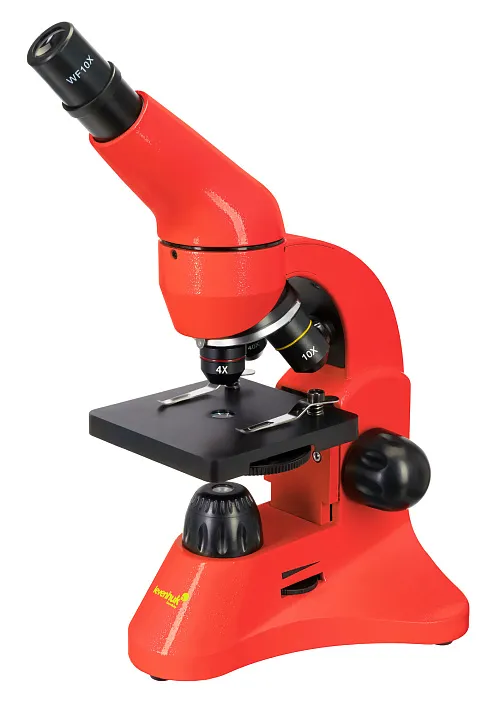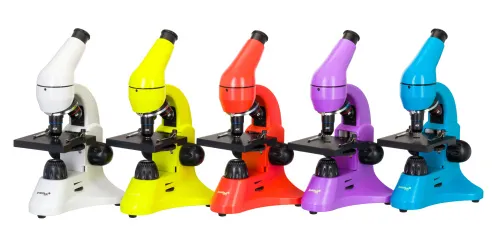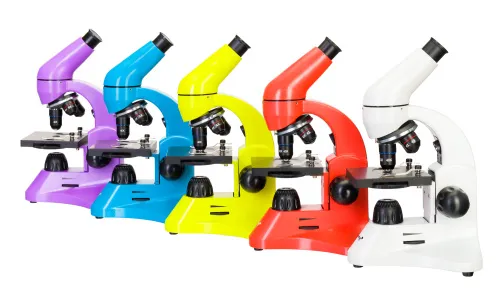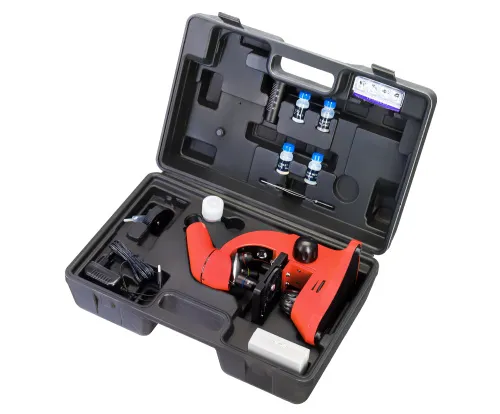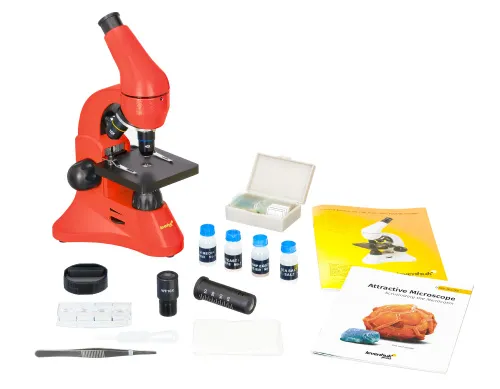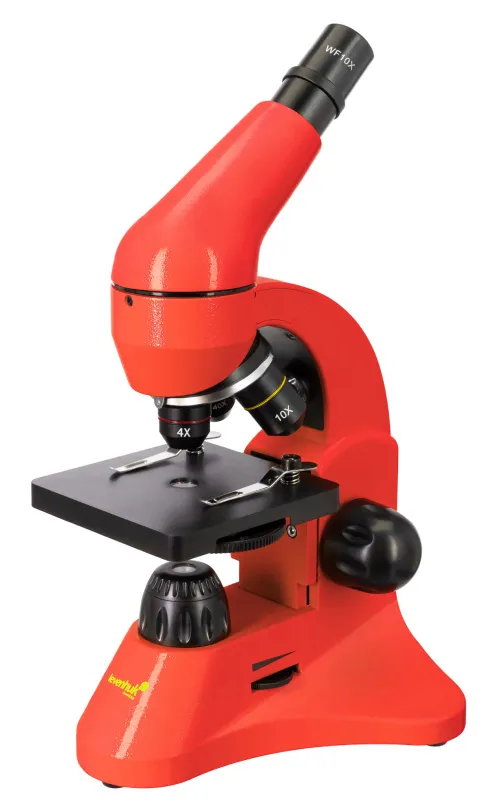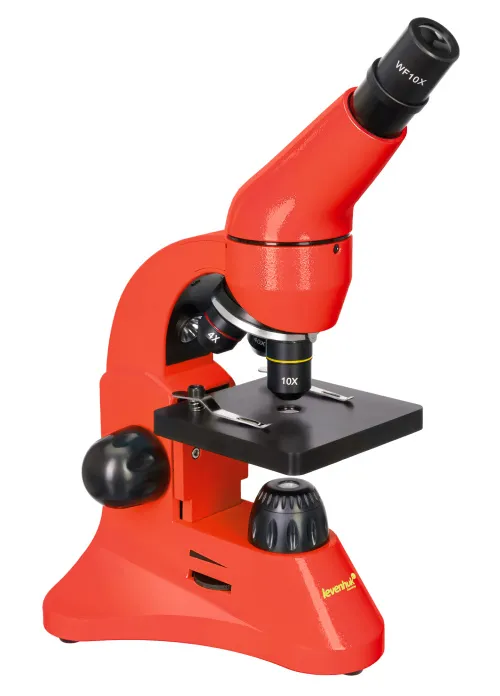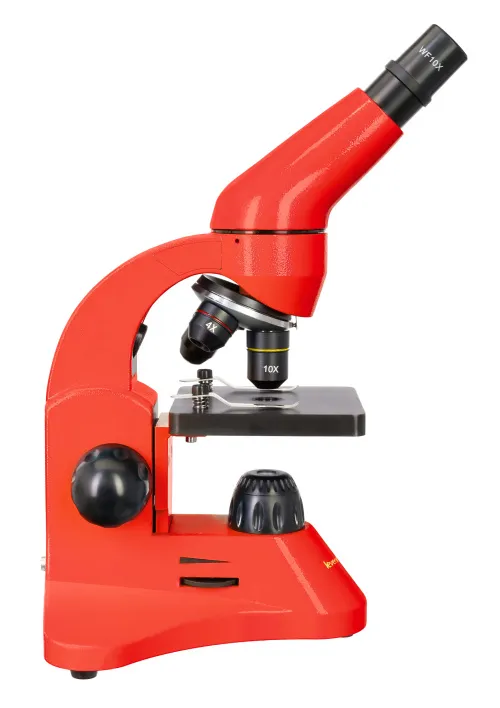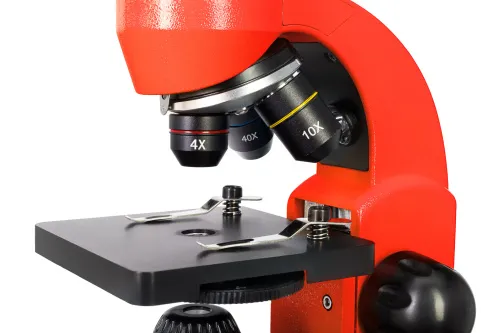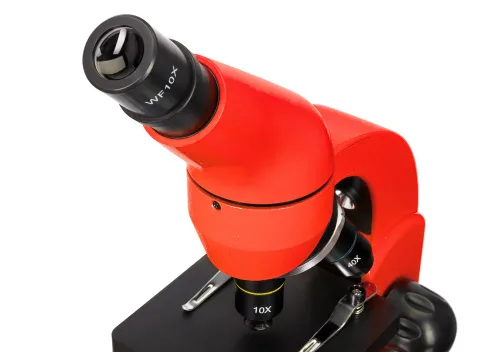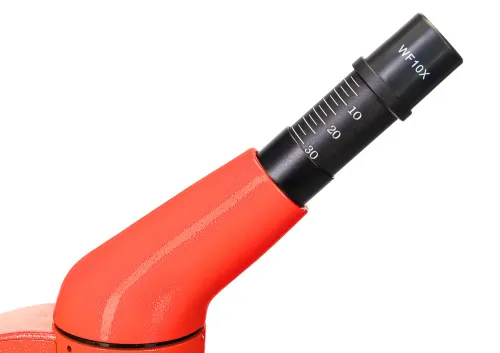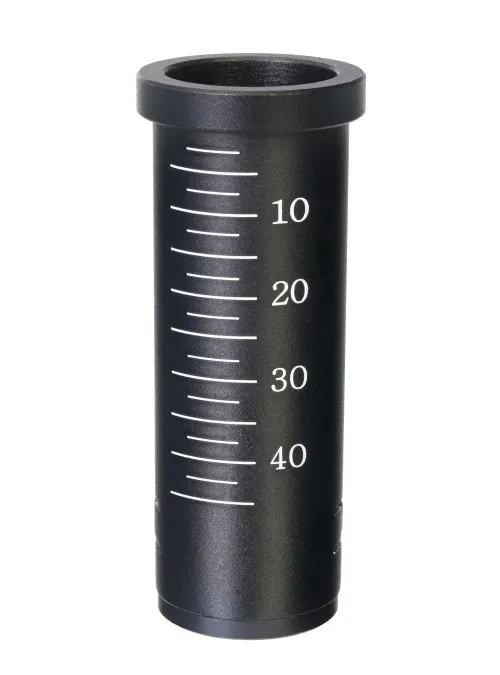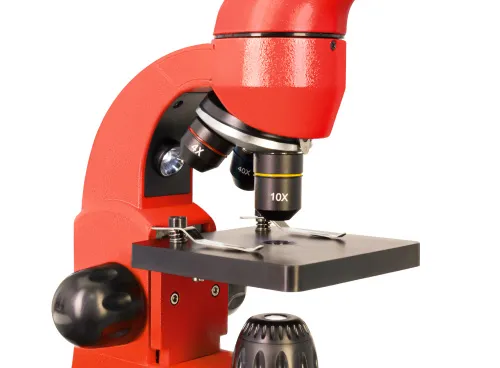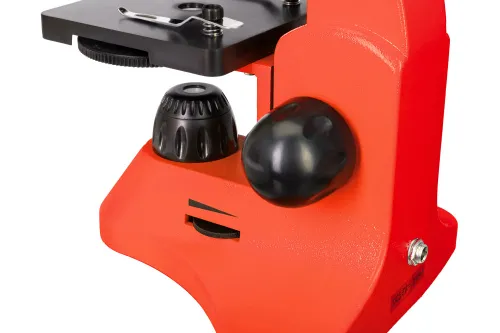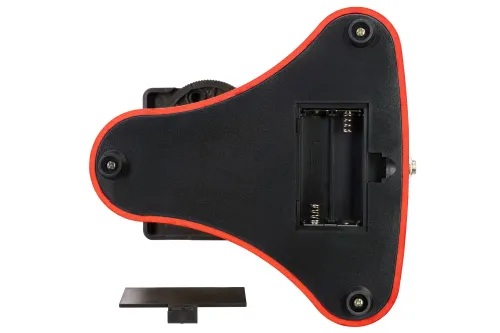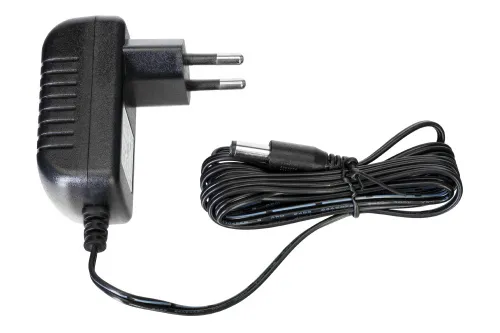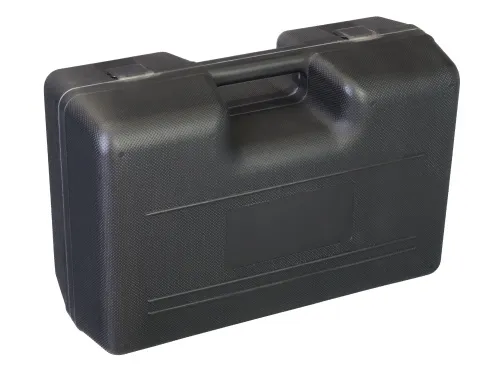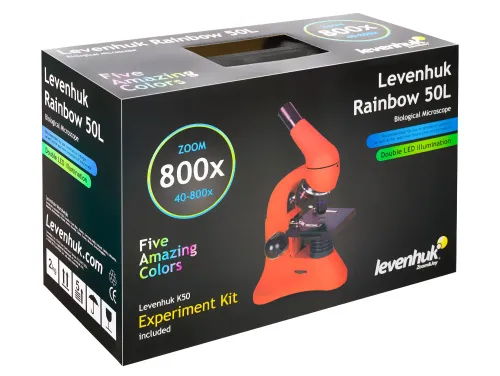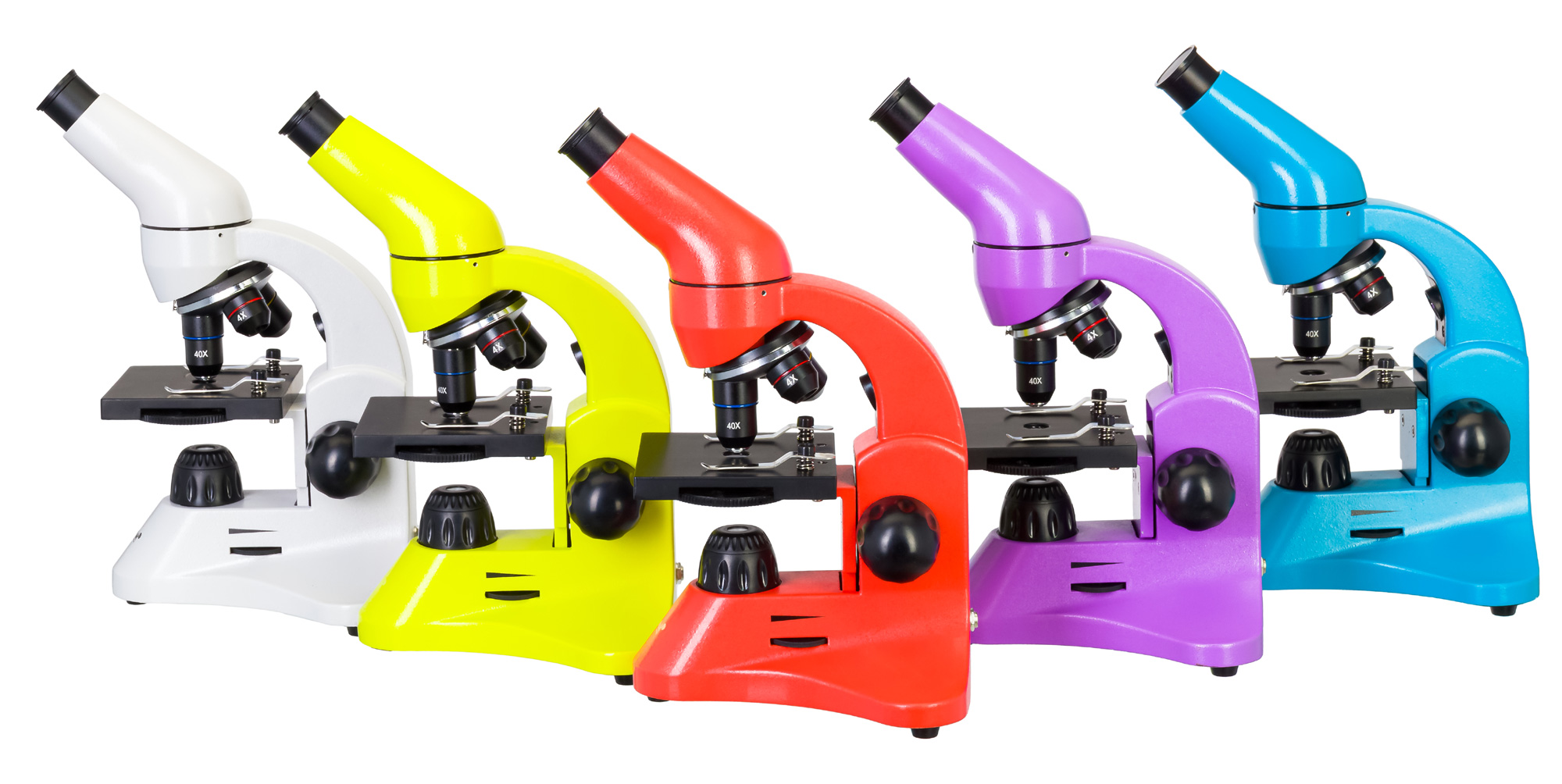Levenhuk Rainbow 50L Microscope
An amazing gift for a keen researcher. Experiment kit included. Magnification: 40–800x
| Product ID | 69075 |
| Brand | Levenhuk, Inc., USA |
| Warranty | lifetime |
| EAN | 5905555007168 |
| Package size (LxWxH) | 18x40x27 cm |
| Shipping Weight | 2.78 kg |
Levenhuk Rainbow 50L Microscope is a great gift for anyone interested in biology and science. The instrument allows for observing and studying familiar objects of our surrounding environment under 40x, 80x, 100x, 200x, 400x and even 800x magnification! With this microscope you can find out how plants, animals and humans are structured; take a look at how microscopic organisms, usually hidden from us, live in their own micro-universe; and, of course, conduct a number of exciting experiments. The kit includes everything a novice researcher might need – in the box you will find prepared microscope slides to observe right away as well as tools allowing you to create your own slides.
Six degrees of magnification
The microscope comes with three objectives and additional Barlow lens, which doubles the magnification of each used objective. The microscope allows you to observe samples under 40x, 80x, 100x, 200x, 400x and even 800x magnifications out of the box!
The optics are made of quality highly transparent glass. For better transmission of light, the lenses are covered with multilayer coating, making produced images clear and sharp.
Bright LED illuminations
The microscope is equipped with two built-in LED illuminations. Lower illumination is used when observing transparent samples. With bottom light turned on you can find life in a drop of aquarium water or analyze the cellular structure of different plants. Top light is required for observing opaque objects; for example, you can examine the structure of a small stone’s surface or notice microscopic scratches invisible to the naked eye on metal surfaces. With two illuminations you also have an opportunity to observe semi-transparent samples – just turn both top and bottom lights on. Illumination brightness is adjustable, so you can easily change it if needed.
Ease of use
The microscope’s body is made of quality plastic; that’s why the instrument is lightweight and durable at the same time. The head is inclined at 45° so you can observe from a more comfortable position. It’s also rotatable 360° around its axis, which is especially convenient during group observations – the head can be easily rotated for the next participant to observe. For power, you can use either an electrical outlet or batteries.
Caution: Please refer to the specifications table for the correct mains voltage and never attempt to plug a 110V device into 220V outlet and vice versa without using a converter. Remember that mains voltage in the U.S. and Canada is 110V and 220–240V in most European countries.
Exciting experiments with microscope
The microscope comes with an experiment kit that allows you to conduct a number of enthralling experiments with the microscope. The kit includes prepared samples to try your new microscope right away, as well as instruments for making your own samples. A useful user guide also provided in the kit includes helpful information on microscope construction, tips on working with it, and a description of interesting experiments.
Case for storage and transportation
The microscope comes in a reliable and convenient plastic case. The case makes storing and transporting the instrument safe and easy – you can be sure that the microscope is protected from dust and impacts.
Features:
- Biological microscope with 40–800x magnification
- 2x Barlow lens included
- Available in five bright colors
- Sturdy and lightweight plastic body
- Upper and lower LED illumination systems
- Experiment kit included
- Comes with a handy plastic case
The kit includes:
- Microscope
- Objectives: 4x, 10x and 40xs
- Eyepiece: WF10x
- 2x Barlow lens
- Stage with clips
- Diaphragm disk
- Condenser
- Built-in upper and lower LED illuminations
- AC adapter
- Plastic case
- Levenhuk K50 Experiment Kit
- User manual and lifetime warranty
Levenhuk K50 Experiment Kit includes:
- "Attractive Microscope. Scrutinizing the Microcosm" User Guide
- Forceps
- Hatchery for Artemia (brine shrimp, or sea-monkeys)
- Microtome
- Flask with yeast
- Flask with pitch
- Flask with sea salt
- Flask with brine shrimp
- 5 ready-to-use specimens
- 5 blank slides
- Dropper
- Dust cover
Some things you can see under a microscope:





Levenhuk Rainbow 50L Microscope is compatible with Levenhuk digital cameras (purchased separately). Levenhuk cameras are installed in the eyepiece tube instead of an eyepiece.
Levenhuk Rainbow Microscopes Comparison Table
| Levenhuk Rainbow 2L | Levenhuk Rainbow 2L PLUS | Levenhuk Rainbow 50L | Levenhuk Rainbow 50L PLUS | |
|---|---|---|---|---|
| Type | biological | biological | biological | biological |
| Head | monocular, inclined 45° | monocular, rotatable 360°, inclined 45° | monocular, rotatable 360°, inclined 45° | monocular, rotatable 360°, inclined 45° |
| Body material | plastic | metal | plastic | metal |
| Magnification, x | 40–400 | 64–640 | 40–800 | 64–1280 |
| Optics material | optical glass | optical glass | optical glass | optical glass |
| Eyepieces | WF10x | WF16x | WF10x | WF16x |
| Objectives | 4х, 10х, 40х | 4х, 10х, 40хs | 4х, 10х, 40хs | 4х, 10х, 40хs |
| Barlow lens | no | no | 2x | 2x |
| Revolving nosepiece | 3 objectives | 3 objectives | 3 objectives | 3 objectives |
| Eyepiece tube diameter, mm | 23.2 | 23.2 | 23.2 | 23.2 |
| Stage, mm | 90x90, with clips | 90x90, with clips | 90x90, with clips | 90x90, with clips |
| Stage moving range, using focusing mechanism, mm | 0–15, vertical | 0–8, vertical | 0–11, vertical | 0–11, vertical |
| Focus | coarse | coarse | coarse | coarse |
| Condenser | NA 0.65, diaphragm disk (6 apertures) | NA 0.65, diaphragm disk (6 apertures) | NA 0.65, diaphragm disk (6 apertures) | NA 0.65, diaphragm disk (6 apertures) |
| Illumination | upper and lower LED illumination with adjustable brightness | upper and lower LED illumination with adjustable brightness | upper and lower LED illumination with adjustable brightness | upper and lower LED illumination with adjustable brightness |
| Power supply | AC adapter or 3 AA batteries | AC adapter or 3 AA batteries | AC adapter or 2 AA batteries | AC adapter or 2 AA batteries |
| Case | no | no | plastic | plastic |
| Levenhuk K50 Experiment Kit* | yes | yes | yes | yes |
* Please note that Levenhuk K50 Experiment Kit is supplied without individual packaging.
| Product ID | 69075 |
| Brand | Levenhuk, Inc., USA |
| Warranty | lifetime |
| EAN | 5905555007168 |
| Package size (LxWxH) | 18x40x27 cm |
| Shipping Weight | 2.78 kg |
| Type | biological, light/optical |
| Microscope head type | monocular |
| Optics material | optical glass |
| Head | 360 ° rotatable |
| Head inclination angle | 45 ° |
| Magnification, x | 40 — 800 |
| Eyepiece tube diameter, mm | 23.2 |
| Eyepieces | WF10x |
| Objectives | achromatic: 4x, 10x, 40xs (spring) |
| Revolving nosepiece | for 3 objectives |
| Stage, mm | 90x90 |
| Stage moving range, mm | 0–11, vertical |
| Stage features | with clips |
| Condenser | N.A. 0.65 |
| Diaphragm | diaphragm disc (6 apertures) |
| Focus | coarse |
| Body | plastic |
| Illumination | LED |
| Brightness adjustment | ✓ |
| Power supply | 2 AA batteries (not included), 220V/50Hz |
| Power supply: batteries/built-in battery | yes |
| Light source type | 3–3.2V (lower and upper illuminators) |
| User level | beginners |
| Assembly and installation difficulty level | easy |
| Application | school/educational |
| Illumination location | dual |
| Research method | bright field |
| Experiment kit included | ✓ |
| Barlow lens | 2x |
| Pouch/case/bag in set | case, dust cover |
and downloads
Levenhuk video guide on choosing the best microscope for kids and schoolchildren
Video review of the attractive Levenhuk Rainbow 50L Microscopes
We have gathered answers to the most frequently asked questions to help you sort things out
Find out why studying eyes under a microscope is entertaining; how insects’ and arachnids’ eyes differ and what the best way is to observe such an interesting specimen
Examples of what you can see with Levenhuk Rainbow 50L, 50L PLUS and D50L PLUS Microscopes
Quick overview of some good microscopes for children
Read this review to learn how to observe human hair, what different hair looks like under a microscope and what magnification is required for observations
Learn what a numerical aperture is and how to choose a suitable objective lens for your microscope here
Learn what a spider looks like under microscope, when the best time is to take photos of it, how to study it properly at magnification and more interesting facts about observing insects and arachnids
This review for beginner explorers of the micro world introduces you to the optical, illuminating and mechanical parts of a microscope and their functions
Short article about Paramecium caudatum - a microorganism that is interesting to observe through any microscope
Armchairarcade.com has published a review on popular Levenhuk Rainbow 50L Microscope

